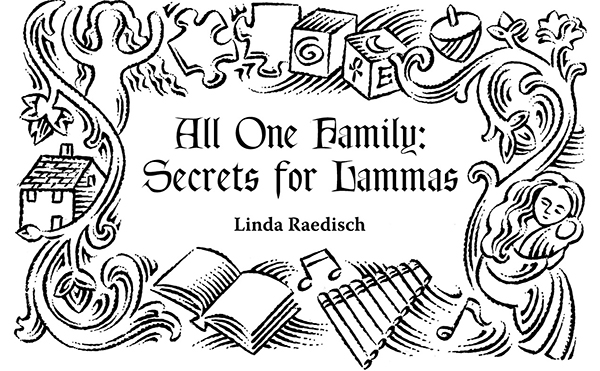
When presented with the problem of coming up with an “All One Family” piece for Lammas, my first impulse was to write about bread. After all, the name Lammas comes from the Old English hlaef maesse, “loaf mass.” That’s loaf as in bread, not meatloaf, thank goodness! (Interestingly enough, our word “mass” as it is used in physics comes from the Greek maza, meaning “barley cake.” Who knew?!) Of course, the first peoples to celebrate this festival of bread baked with the fruits of the first harvest did not do so with a church mass but in their own homes and fields, as many witches do today.
Look up Lammas in any halfway-decent dictionary and you’ll eventually come to “Lammastide.” That’s right: Lammas used to be a whole season. Nowadays the early days of August are a sort of non-season. It’s still summer, but fall clothes and school supplies are already on sale, and those of us who have not yet gone away on vacation are realizing it may not happen this year. And yet this is a deeply rooted festival, old already in Shakespeare’s time. When the Nurse remarked that Juliet’s birthday was coming up “on Lammas Eve at night,” everyone in the audience knew which date she was talking about. Country folk especially would have looked forward to Lammastide because it meant the privations of summer were ending and there would be bread on the table again.
If your children are used to having bread on the table every day, not to mention milk, fruit, vegetables, enriched pasta, and maybe even dessert, you might find it hard to help them build up a sense of anticipation for Lammas. So let’s see what secrets the ancient festival might be hiding: there must be something in there to awaken the imagination of twenty-first century youth. In medieval England, Lammastide was when everyone was allowed to bring their sheep and cows to graze on the Lammas lands, communal fields whose crops had already been harvested. Okay, not so interesting. The tenth-century Leechbook of Bald, a medical text, counsels against bleeding the patient at Lammastide, though it is presumably good practice at other times of the year. Still not sold? Let’s turn to the Celts for help.
Late in its history, Lammas’ Celtic counterpart, Lughnasadh, was transferred to the last Sunday in July so it would fit more neatly into the Christian calendar. On this day, sometimes called “Garland Sunday,” people flocked to the nearest hilltop to enjoy the sunshine, share a meal and have a bit of fun. South of the Firth of Forth in Scotland, the festivities were centered around a flag stuck in the top of a tower of sod. Each village had its own tower upon which to flaunt its own colors.
If you’ve read Rick Riordan’s young adult novel The Lightning Thief, you’ll already be familiar with the game of Capture the Flag as it is played at Camp Half-Blood. I haven’t, so I wasn’t; I had to look it up. Basically, there are two teams. Each team has a base with a flag. The object of the game is to capture the other team’s flag and bring it to your team’s base, with a lot of rough and tumble in the process. So where does the fun come in? In making your team’s flag, of course!
It doesn’t have to be fancy. The famous—no, make that sacred—Fairy Flag of Dunvegan Castle is actually quite plain. Why is it sacred? Because it was presented to Clan MacLeod by an actual fairy, or so the legend goes. It’s well known that fairies are especially good at needlework, as were the daughters of the Danish Viking Ragnar Lodbrok. They wove a magical banner that could predict the outcome of a battle by either snapping proudly in the wind or drooping pitifully on its post. The name of this banner was Hrafn, meaning, “raven,” so I think it’s safe to assume the girls had stitched the image of a raven upon it. (In a real-life game of Capture the Flag, Hrafn was seized by the Anglo-Saxons, but of course the Danes were expecting that.)
Your Capture the Flag flag doesn’t have to be a work of art, but it should bear some symbol that the team can rally round. It should also be durable, since it’s going to have to withstand some scuffling. The Vikings had always been fond of ravens, maybe because the sight of one fluttering on the battlefield reminded the enemy that they might soon be making a meal for these feathered scavengers. Wolves and dragons are also good for striking fear into the hearts of the other team.
If you, like me, are no fairy seamstress, or even Betsy Ross, you can make a passable banner out of colored felt. Once you’ve chosen an image, you can cut it out in silhouette and appliqué it onto a contrasting ground with a simple blanket stitch, no hemming needed. It’s true that felt won’t hold up in a rainstorm, but who wants to play Capture the Flag in the rain anyway?